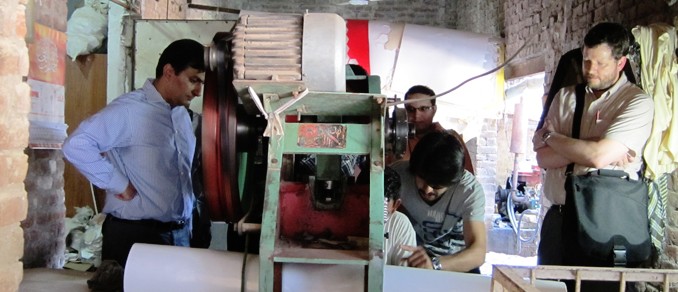Organizational Barriers to Technology Adoption
Evidence from Soccer-Ball Producers in Pakistan
Investigators: CDEP Affiliate Amit Khandelwal, CDEP Co-Director Eric Verhoogen, David Atkin of MIT and Azam Chaudhry and Shamyla Chaudry of the Lahore School of Economics.
Observers of the process of technological diffusion have been struck by how slow it is for many technologies. Why? The question is key for economic development and growth, but also difficult to study, especially among manufacturing firms. Datasets on firms usually contain little direct information on technology use, and usually researchers can only observe technological diffusion after the fact, not while it is going on. In this project, the research team invented a new technology that reduces costs for producing soccer balls and randomly gave it out to a subset of firms in a large cluster of firms in Sialkot, Pakistan. The standard soccer ball is stitched using hexagons and pentagons cut from sheets of an artificial leather called rexine. The new technology is a new layout for cutting pentagonal panels that reduces waste of rexine, as well as a new cutting die to implement the layout.
The research team gave out the technology to a subset of firms in May 2012 and is continuing to survey firms to watch the adoption process. In the first year, a number of firms adopted the technology -- including one of the largest firms in town -- but overall the rate of adoption remained puzzlingly low. The research team hypothesized that a misalignment of incentives within firms is a key reason for non-adoption: most cutters in the sector are paid piece-rate wages and the new technology, although is saves on material costs, slows them down. The cutters, realizing that their wages will fall, have found ways to resist adoption. To probe this hypothesis, the researchers designed a second experiment: in half of the firms that originally received the technology, they offered cutters a lump-sum bonus equal to a monthly wage to cutters if they could demonstrate competence in using the new technology. This incentive payment, small from the point of view of the cost savings from the technology, had a statistically significant effect on adoption. The findings suggest that the misalignment of incentives is indeed an important reason for non-adoption of the cost-reducing technology.
The main research paper for this project was published in The Quarterly Journal of Economics, Vol 132, Issue 3, August 2017, Pages 1101-1164.
In a related project, the authors are investigating spillovers of the new technology from initially treated to initially non-treated firms, and the channels through which such spillovers occur. In another related project (funded by the Private Enterprise Development in Low-Income Countries (PEDL) initiative), the research team is providing randomly allocated subsidies for the purchase of high-quality imported rexine and tracking the effects on firms' use of other inputs and firms' choices about types of balls to produce, as well as the prices and destinations of exports. A brief mention of this related project is the local press is here.
The project is part of CDEP’s Firms and Innovation Initiative and has been funded by the International Growth Centre (IGC). The IGC has produced a short video on the project:
The video is also available on vimeo.
Eric Verhoogen has a related article in the Harvard Business Review on "How Labor Standards Can Be Good for Growth."
Media Coverage:
Canada AM (national morning news), July 11, 2014
Marketplace (American Public Media), June 9, 2014.
The Atlantic online, July 2, 2014.
The New Republic online, June 13, 2014
Wall Street Journal online, April 28, 2014.
Columbia News, June 23, 2014.
Valor Econômico (Brazil), July 2, 2015
Chris Blattman's blog, May 2, 2016
Published papers related to this project:
David Atkin, Azam Chaudhry, Shamyla Chaudry, Amit Khandelwal, and Eric Verhoogen. Organizational Barriers to Technology Adoption: Evidence from Soccer-Ball Producers in Pakistan, Quarterly Journal of Economics, 132 (2): 1101-1164, Aug. 2017.
David Atkin, Azam Chaudhry, Shamyla Chaudry, Amit Khandelwal, Tariq Raza and Eric Verhoogen, On the Origins and Development of Pakistan’s Soccer-Ball Cluster, World Bank Economic Review (ABCDE Conference Papers & Proceedings), 2016.
David Atkin, Azam Chaudhry, Shamyla Chaudry, Amit Khandelwal and Eric Verhoogen, Mark-up and Cost Dispersion Across Firms: Direct Evidence from Producer Surveys in Pakistan, American Economic Review Papers & Proceedings, May 2015.
Eric Verhoogen, How Labor Standards Can Be Good for Growth. Harvard Business Review (online), April 27, 2016.

